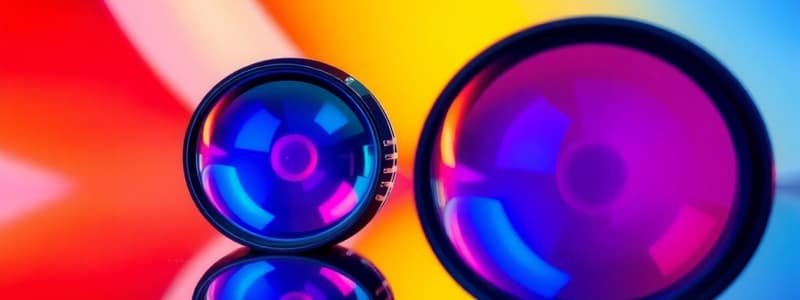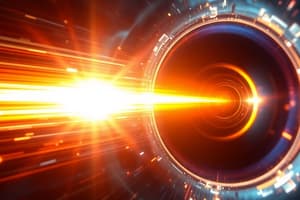Podcast
Questions and Answers
What describes the behavior of light when it reflects off a surface?
What describes the behavior of light when it reflects off a surface?
- The angle of incidence equals the angle of reflection. (correct)
- The angle of incidence equals the angle of refraction.
- The incident ray and reflected ray are in different planes.
- The speed of light decreases.
Which type of mirror is used primarily in security applications?
Which type of mirror is used primarily in security applications?
- Plane Mirror
- Convex Mirror (correct)
- Spherical Mirror
- Concave Mirror
What happens to the speed of light when transitioning from air to glass?
What happens to the speed of light when transitioning from air to glass?
- It remains the same.
- It becomes zero.
- It increases.
- It decreases. (correct)
What type of image does a plane mirror produce?
What type of image does a plane mirror produce?
In magnification, what does it indicate when M > 1?
In magnification, what does it indicate when M > 1?
Flashcards
Refraction of Light
Refraction of Light
The bending of light as it passes from one medium to another (e.g., air to water).
Law of Reflection
Law of Reflection
The angle at which light strikes a surface is equal to the angle at which it bounces off.
Concave Mirror
Concave Mirror
A mirror that curves inwards, converging light rays to a focal point.
Convex Mirror
Convex Mirror
Signup and view all the flashcards
Plane Mirror
Plane Mirror
Signup and view all the flashcards
Study Notes
Lenses and Mirrors
- Light reflects off surfaces. The angle of incidence equals the angle of reflection, and all three (incident ray, reflected ray and normal) lie in the same plane.
- Light bends when passing between different mediums (e.g., air to glass). The speed of light changes in different mediums.
- Plane mirrors create virtual, upright, and same-sized images.
- Spherical mirrors (concave and convex) form real or virtual images depending on the object's position. Concave mirrors are used in telescopes and headlights, while convex mirrors are often used for security or as rearview mirrors.
- Mirror equations relate object distance, image distance, focal length, and magnification.
- Convex lenses converge light and are used in magnifying glasses and cameras; concave lenses spread light and are used in peepholes and some corrective lenses.
- Lens equations describe relationships between object distance, image distance, focal length, and magnification of lenses.
- Focal point is the point where light rays converge or appear to diverge. Principal axis is the straight line that passes through the center of curvature and the lens/mirror's pole.
- Center of curvature, is the center of the sphere the mirror is a part of.
Electromagnetic Spectrum
- The electromagnetic spectrum is the range of all types of electromagnetic radiation. Electromagnetic waves consist of oscillating electric and magnetic fields, traveling at the speed of light in a vacuum.
- Electromagnetic waves are transverse waves that can travel through a vacuum unlike sound waves. All waves in the spectrum travel at the speed of light in a vacuum.
- Wavelength and frequency are inversely related (c = λf) where c is the speed of light, λ is wavelength, and f is frequency.
- The spectrum is ordered from longest wavelength (lowest energy) to shortest wavelength (highest energy): radio waves, microwaves, infrared radiation, visible light, ultraviolet light, X-rays, and gamma rays.
- Each type of wave has specific wavelengths, uses, and potential risks.
Wave Properties and Relationships
- Wavelength is the distance between two peaks of a wave.
- Frequency is the number of wave cycles per second (measured in Hz).
- Energy of a photon (E = hf) where h is Planck's constant (6.63 x 10-34 J·s).
- Wavelength and frequency are inversely related in the electromagnetic spectrum.
- As frequency increases, energy also increases. As wavelength decreases, frequency and energy increase.
Studying That Suits You
Use AI to generate personalized quizzes and flashcards to suit your learning preferences.




